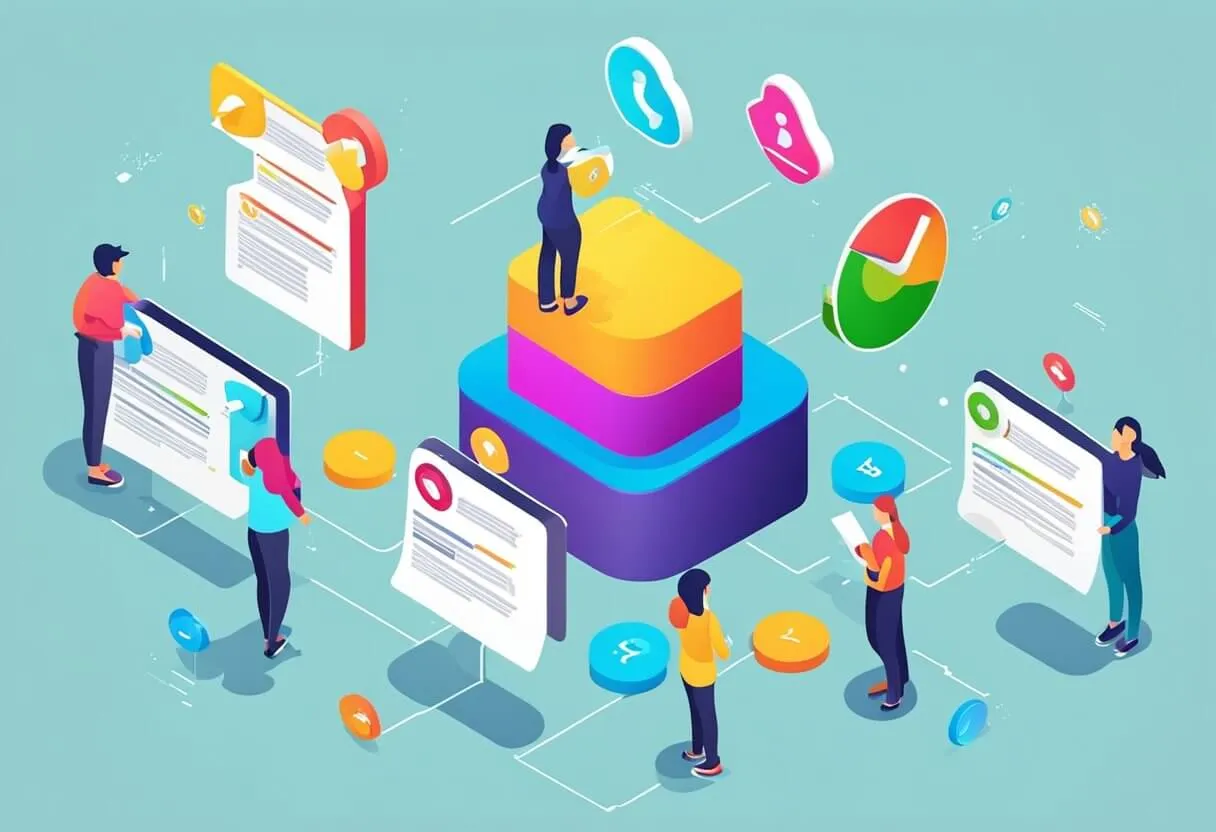Customer feedback is an essential aspect of any business. It provides valuable insights into how customers perceive a company’s products or services, which can help improve future offerings and customer satisfaction. Understanding customer feedback is crucial for businesses looking to remain competitive in today’s market.
Methods of gathering customer feedback can vary, from surveys and focus groups to online reviews and social media posts. Tools for collecting customer feedback can also vary, with many businesses utilizing customer relationship management (CRM) software to manage and analyze feedback. Analyzing customer feedback is also important, as it can help identify areas for improvement and potential opportunities for growth.
Improving services based on feedback is a key component of any successful customer feedback strategy. Dealing with negative feedback can be challenging, but it is important to address these concerns and work towards a resolution. Maximizing positive customer feedback helps and can also be beneficial, as it can help build customer loyalty and attract new customers. Incentivizing feedback can be a useful tactic for encouraging customers to provide feedback, whether through discounts, rewards, or other incentives.
Key Takeaways
-
Customer feedback is an essential aspect of any business, providing valuable insights into how customers perceive a company’s products or services.
-
Gathering and analyzing customer feedback can help identify areas for improvement and potential opportunities for growth.
-
Improving services based on feedback, dealing with negative feedback, maximizing positive feedback, and incentivizing feedback are all important components of a successful customer feedback strategy.
Understanding Customer Feedback

Customer feedback is crucial to the success of any business. It is the information that a business collects directly from its customers about their preferences and experiences with a product or service. Customers can share their opinions through surveys, interviews, and other channels to tell a company whether they’re satisfied or dissatisfied.
Customer feedback can provide valuable insights into customer needs, wants, and expectations. It can also help businesses identify areas for improvement and make changes to their products or services to better meet customer needs.
To understand all your customer feedback well, it is important to know who is saying what. All customers are important, but when it comes to choosing what to change or build, not all customer feedback holds the same weight. An important part of understanding customer feedback is knowing who is saying what.
Customer feedback can be used to measure customer satisfaction and customer experience (CX). Customer satisfaction is the overall feeling a customer has about a product or service, while CX is the sum of all interactions a customer has with a business.
To collect customer feedback, businesses should make it easy for customers to leave feedback. Feedback doesn’t need to be detailed and long, but it does need to be easy. Collecting feedback using a variety of channels is also important, as all customers respond to feedback requests differently.
In conclusion, understanding customer feedback is essential to improving customer satisfaction and CX. It provides valuable insights into customer needs and expectations, and can help businesses identify areas for improvement. By making it easy for customers to leave feedback and collecting feedback through a variety of channels, businesses can better understand their customers and make changes to better meet their needs.
Methods of Gathering Customer Feedback

When it comes to gathering customer feedback, there are several methods that businesses can use to gain insights into their customers’ experiences. Here are some of the most effective methods for gathering customer feedback:
Surveys
Surveys are one of the most common and effective methods for gathering customer feedback. They can be conducted in a variety of formats, including online, in-person, and through phone calls. NPS surveys and customer satisfaction surveys are two popular types of surveys that businesses use to gather feedback. Surveys are an excellent way to gather quantitative data about customer experiences, and they can be used to identify trends and patterns in customer feedback.
Social Media
Social media is another effective method for gathering customer feedback. By monitoring social media channels and posts, businesses can gain insights into what customers are saying about their products or services. Social media can also be used to engage with customers and respond to their feedback in real-time.
Direct Feedback
Direct feedback is feedback that businesses actively solicit from their customers. This can include things like solicited customer feedback through surveys, email campaigns, and feedback forms on websites. Direct feedback is an excellent way to gather specific feedback on a particular product or service.
Indirect Feedback
Indirect feedback is feedback that businesses receive without actively soliciting it. This unsolicited customer feedback can include things like word-of-mouth recommendations, public reviews, and online forums. Indirect feedback can be an excellent way to gather feedback on customer experiences that businesses may not have been aware of.
Focus Groups
Focus groups are a qualitative research method used to gather feedback from a small group of customers. Focus groups are typically conducted in-person and can be used to gather detailed feedback on specific products or services. Focus groups are an excellent way to gather in-depth feedback on customer experiences.
Customer Interviews
Customer interviews are another qualitative research method used to gather feedback from customers. Interviews can be conducted in-person or over the phone, and they can be used to gather detailed feedback on specific products or services. Customer interviews are an excellent way to gain insights into customer experiences and to identify areas for improvement.
Overall, there are several effective methods for gathering customer feedback. By using a combination of these methods, businesses can gain valuable insights into their customers’ experiences and make data-driven decisions to improve their products and services.
Tools for Collecting Customer Feedback

When it comes to collecting your customer feedback data, there are numerous tools available to businesses. Here are some of the most commonly used methods:
Email is a popular way to gather customer feedback. Businesses can send surveys or feedback requests to their customers through email. This method is cost-effective and efficient, but it may not be the best option for gathering immediate customer feedback important now.
Phone Calls
Phone calls are a more personal way to collect feedback. Businesses can call their customers and ask for feedback directly. This method allows for real-time conversations and can help businesses gain a deeper understanding of their customers’ needs and concerns.
Live Chat
Live chat is another way to gather customer feedback in real-time. By integrating a live chat feature on their website, businesses can communicate with their customers and get immediate feedback. This method is particularly useful for businesses that want to provide support and assistance to their customers.
In-App Surveys
In-app surveys are becoming increasingly popular as more businesses move to mobile apps. By integrating surveys into their apps, businesses can gather feedback from their customers while they are using the app. This method is convenient for customers and can provide businesses with valuable insights into how their app is performing.
Customer Feedback Software
Customer feedback software is designed to help businesses collect, analyze, and act on customer feedback. These tools can include features such as surveys, feedback forms, and sentiment analysis. Some popular customer feedback software options include HubSpot, Alchemer, and G2.
Overall, businesses have a variety of tools at their disposal when it comes to collecting customer feedback. By using a combination of these methods, businesses can gain a deeper understanding of their customers’ needs and improve their products and services accordingly.
Analyzing Customer Feedback
Analyzing customer feedback is an essential part of the customer feedback loop. It involves the process of breaking down customer feedback into something that is easy to understand and insightful. By analyzing customer feedback, businesses can identify areas where they are succeeding and areas where they need to improve.
Customer feedback management is the process of collecting, analyzing, and acting upon customer feedback. It is a crucial aspect of any successful business as it provides actionable customer insights that can be used to improve the overall customer experience. By managing customer feedback effectively, businesses can identify patterns and trends that can help them make informed decisions.
There are several ways to analyze customer feedback, and the method chosen will depend on the goals of the business. Some common methods include sentiment analysis, categorization, and text analytics. Sentiment analysis involves analyzing the emotional tone of customer feedback, while categorization involves grouping feedback based on common themes or topics. Text analytics involves using natural language processing techniques to extract insights from customer feedback.
To effectively analyze customer feedback, businesses should consider the following steps:
-
Collect feedback: Collect feedback from a variety of sources, including surveys, social media, and customer service interactions.
-
Categorize feedback: Group feedback based on common themes or topics to identify areas of improvement.
-
Analyze sentiment: Use sentiment analysis to understand the emotional tone of customer feedback.
-
Identify trends: Look for patterns and trends in customer feedback to identify areas where the business is succeeding and areas where it needs to improve.
-
Take action: Use the insights gained from customer feedback to make informed decisions and improve the overall customer experience.
In conclusion, analyzing customer feedback is a critical aspect of customer feedback management. By collecting, categorizing, and analyzing customer feedback, businesses can gain actionable insights that can be used to improve the overall customer experience.
Improving Services Based on Feedback
Customer feedback is a valuable tool for businesses looking to improve their services. By listening to what customers have to say, businesses can identify areas of customer journey that need improvement and make changes to increase customer satisfaction, generate more revenue, and enhance brand loyalty.
Customer Service
One of the most important areas to focus on when it comes to improving services based on feedback is the customer service team. By soliciting customer service feedback, businesses can identify areas where their support teams are falling short and make changes to improve the overall customer experience.
Some ways to improve customer service based on feedback include:
-
Providing additional training to support teams to ensure they have the necessary skills to handle customer inquiries effectively.
-
Offering multiple channels for customers to reach out to support teams, such as email, phone, and chat.
-
Implementing a ticketing system to ensure that customer inquiries are tracked and resolved in a timely manner.
-
Providing customers with self-service options, such as a knowledge base or FAQ section on the company’s website.
Product Improvement
Another area where businesses can use customer feedback to improve their services is product improvement. By soliciting product reviews and feedback, businesses can identify areas where their products are falling short and make changes to improve their product offerings.
Some ways to improve products based on feedback include:
-
Conducting user testing to identify usability issues with products.
-
Gathering feedback from product teams to identify areas for improvement in product design.
-
Offering incentives for customers to leave reviews, which can help businesses identify areas where their products are falling short.
-
Using customer feedback to inform future product offerings and updates.
Brand Enhancement
Finally, businesses can also use customer feedback to enhance their brand. By soliciting feedback on brand perception and loyalty, businesses can identify areas where they need to improve their brand messaging and make changes to enhance customer loyalty.
Some ways to enhance brand based on feedback include:
-
Conducting market research to identify areas where the brand is falling short in terms of customer perception.
-
Offering incentives for customers to leave reviews, which can help businesses identify areas where their brand messaging needs improvement.
-
Using customer feedback to inform future brand messaging and marketing efforts.
Overall, businesses that take customer feedback seriously and use it to improve their services are more likely to succeed in the long run. By focusing on customer service, product improvement, and brand enhancement, businesses can enhance customer satisfaction, generate more revenue, and increase brand loyalty.
Dealing with Negative Feedback
No matter how great customers feel that a product or service is, it is inevitable that some customers will provide negative feedback. Negative feedback can come in the form of customer complaints, bug reports, or returns. However, it is important to remember that negative feedback can be an opportunity for growth and improvement. Here are some tips for dealing with negative feedback:
-
Listen actively: When receiving negative feedback, it is important to listen actively and not become defensive. Take the time to fully understand the customer’s concerns and ask clarifying questions if necessary.
-
Apologize sincerely: Even if the negative feedback is not entirely justified, it is important to apologize sincerely for any inconvenience or frustration caused. This can help to defuse the situation and show the customer that their feedback is valued.
-
Take action: Once the issue has been identified, take action to address it. This may involve fixing a bug, improving a product feature, or changing a policy. Communicate the steps taken to the customer to show that their feedback has been taken seriously.
-
Follow up: After taking action, follow up with the customer to ensure that their issue has been resolved to their satisfaction. This can help to build trust and loyalty with the customer.
-
Use the feedback to improve: Negative feedback can be a valuable source of information for improving products and services. Use the feedback to identify areas for improvement and make changes accordingly.
By following these tips, businesses can turn negative feedback into an opportunity for growth and improvement.
Maximizing Positive Feedback
Positive feedback from customers is essential for the success of any business. It not only helps in building customer loyalty but also attracts new and loyal customers. Therefore, businesses should strive to maximize the positive feedback they receive. Here are some tips on how to do that:
1. Provide Excellent Customer Service
Providing excellent customer service is the key to receiving positive feedback happy customers. Customers are more likely to leave positive feedback if they feel that their needs have been met and that they have received exceptional service. Therefore, businesses should invest in training their employees to provide excellent customer service.
2. Collect Customer Feedback
Collecting customer feedback is essential for businesses to understand their customers’ needs and preferences. It also helps in identifying areas for improvement. Businesses can collect feedback through surveys, feedback forms, or by simply asking customers for their opinions.
3. Respond to Positive Feedback
Responding to positive feedback is just as important to customer success as responding to negative feedback. It shows customers that their feedback is valued and appreciated. Businesses should respond to positive feedback promptly and thank customers for their kind words.
4. Encourage Customers to Leave Positive Feedback
Businesses can encourage customers to leave positive feedback by making it easy for them to do so. They can include links to their social media pages or review sites on their website, or they can send follow-up emails asking customers to leave feedback.
5. Reward Promoters
Promoters are customers who are extremely satisfied with a business and are likely to recommend it to others. Businesses should identify these customers and reward them for their loyalty. This can be done through loyalty programs or by offering incentives for referrals.
6. Measure Happiness
Measuring customer happiness is essential for businesses to understand how satisfied their customers are. Businesses can measure happiness through customer surveys, feedback forms, or by analyzing customer interactions with their products or services.
In conclusion, businesses should strive to maximize positive feedback from unhappy customers by providing excellent customer service, collecting customer feedback, responding to positive feedback, encouraging customers to leave feedback, rewarding promoters, and measuring happiness. By doing so, businesses can build customer loyalty, attract new customers, and ultimately increase their bottom line.
Incentivizing Feedback
Incentivizing customer feedback can be an effective way to gather valuable insights and improve customer satisfaction. However, it is important to choose the right incentives and avoid potential drawbacks.
Benefits of Incentivizing Feedback
Offering incentives can increase the response rate of feedback and feature requests too, as customers are more likely to take the time to complete a survey or leave a review if they receive something in return. Incentives can also encourage customers to provide more detailed and honest feedback, as they feel their time and effort are being valued.
Types of Incentives
There are various types of incentives that can be offered to customers in exchange for their feedback. Monetary incentives, such as cash, gift cards, or discounts, are often effective in motivating customers to participate. Non-monetary incentives, such as free samples or exclusive access to new products, can also be appealing.
Challenges of Incentivizing Feedback
Offering incentives can also have drawbacks. For example, some customers may provide biased or insincere feedback in order to receive the incentive. It is important to carefully choose incentives that are relevant to the customer and do not compromise the quality of the feedback received. Additionally, incentives can be costly, so it is important to consider the return on investment.
Choosing the Right Incentives
When choosing incentives, it is important to consider the target audience and the goals of the feedback request. For example, a discount on a future purchase may be more appealing to customers who have already made a purchase, while a free sample may be more effective in attracting new customers. It is also important to communicate the incentive clearly and ensure it is easy to redeem.
Overall, incentivizing customer feedback can be an effective way to gather valuable insights and improve customer satisfaction. However, it is important to carefully consider the benefits and challenges and choose the right incentives to ensure the quality and relevance of the feedback received.
Customer Feedback Strategy
A well-defined customer feedback strategy is essential for any business that wants to grow and succeed. It helps businesses to understand their customers’ needs, preferences, and pain points, which in turn enables them to improve their products, services, and customer experience.
Here are some key steps to creating an effective customer feedback strategy:
1. Set Clear Goals
The first step in developing a customer feedback strategy is to define clear goals. Businesses need to determine what they want to achieve with their customer feedback program. For example, they may want to improve their customer satisfaction score, reduce customer churn, or identify new product opportunities.
2. Choose the Right Feedback Channels
Businesses need to choose the right channels for collecting customer feedback. This could include surveys, focus groups, social media, or customer and support team interactions. It’s important to choose channels that are convenient for customers and that provide actionable insights.
3. Ask the Right Questions
When collecting customer feedback, it’s important to ask the right questions. Businesses should focus on open-ended questions that allow customers to provide detailed feedback. They should also avoid leading questions that could bias the results.
4. Analyze and Act on Feedback
Once businesses have collected customer feedback, they need to analyze it and take action. This could involve categorizing feedback, identifying trends, and prioritizing improvements. It’s important to communicate the results of the feedback program to stakeholders and to track progress over time.
By following these steps, businesses can develop a customer feedback strategy that helps them to better understand and serve their customers.
Frequently Asked Questions
What are some effective strategies for collecting customer feedback?
Businesses can use a variety of strategies to collect customer feedback. Some of the most effective strategies to get customer feedback include conducting surveys, hosting focus groups, analyzing customer reviews, and using social media to engage with customers. Additionally, businesses can collect feedback through customer service interactions and by monitoring online discussions related to their brand.
How can businesses use customer feedback to improve their services?
Customer feedback can provide valuable insights into the strengths and weaknesses of a business. By analyzing feedback, businesses can identify areas for improvement and make changes to their services that better meet the needs of their customers. This can lead to increased customer satisfaction, loyalty, and retention.
What are some common mistakes businesses make when collecting customer feedback?
One common mistake businesses make when collecting customer feedback is not asking the right questions. It’s important to ask questions that are specific, relevant, and get actionable feedback. Another mistake is not following up with customers after receiving feedback. Businesses should acknowledge feedback and take action to address any issues raised by customers.
What are some examples of successful customer feedback implementation?
There are many examples of businesses that have successfully implemented customer feedback. For example, Airbnb used customer feedback to improve its search functionality, resulting in a 30% increase in bookings. Similarly, Starbucks used customer feedback to develop its mobile ordering system, which now accounts for a significant portion of its sales.
What is the importance of analyzing customer feedback?
Analyzing customer feedback is important because it allows businesses to identify trends and patterns in customer behavior and preferences. This information can be used to make data-driven decisions that improve the customer experience and drive business growth.
What are some best practices for creating a customer feedback survey?
When creating a customer feedback survey, it’s important to keep the survey short and focused. Use clear and concise language, and avoid using jargon or technical terms that customers may not understand. Additionally, it’s important to ask both closed-ended and open-ended questions to gather both quantitative and qualitative data. Finally, be sure to test the survey with a small group of customers before sending it out to a larger audience.


